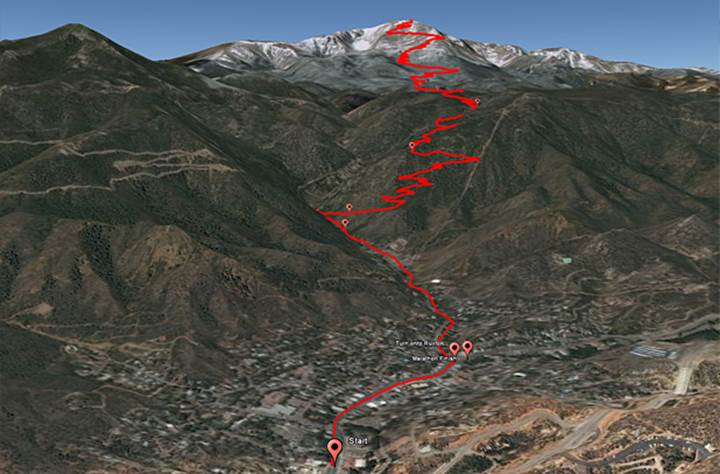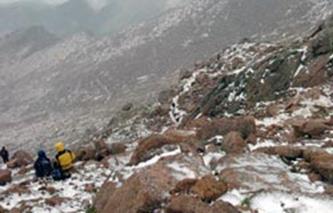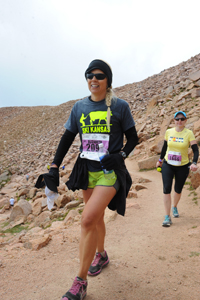Pikes Peak Half Marathon…
A Flatlanders’s Foggy-Brained Tale
Elizabeth Stewart
Ski Kansas. And if you can’t do that, run the Pikes Peak Ascent/Half Marathon, a 13+ mile hill run with an elevation gain of 7815 feet.
Except let’s set the record straight right here and now and say, for the vast majority of the 1800 people signed up… this ain’t no “run.” It’s a determined and grim-faced jog, the most heart-pounding of power hikes, much ado about shuffling and stumbling, and yes, my flatland friends, a death march. Repetitive Forward Motion (RFM), yes. But RUN? Not so much.
And yet, it was an absolute blast.
 |
| Here’s the course. AVERAGE grade the entire way is 11%. Suggestion – don’t look at this until AFTER the race!!! (Weirdly enough, the PP race began as a contest between smokers and non-smokers. Whaddya think they were smoking???) |
During the carb-loading dinner the night before, you meet plenty of other newbies and flatlanders, most of whom look as bewildered as you do and obsessed with the question – to carry water or not? You see a video of some mountain men (MM) type runners skipping over boulders on the summit, and then some greenish-hued folks hunched over as they walk, and you wonder which end of the mountain sickness spectrum you will fall. You get a last minute email from your mother with the simple wish: “Good luck. Hope you don’t get diarrhea. Love, Mom.”
The next morning is the usual pre-run jumble of porta-potty lines and trying to find a parking space. At some point during the night I made the executive decision to NOT wear my water bottle belt and instead tie another layer around my waist. Standing at the start line, I panicked when I saw everyone HOLDING water bottles and smoothly fished a bottle out of the trash, hoping that any backwash was that of an elite runner. By the way, those elite runners? A small pack of them took off in the first wave, and no doubt they actually ran. The remaining 1500 runners set off in a hopeful clump that morphed into a huge bottleneck when the road through Manitou Springs actually hit the Barr Trail trailhead. Imagine the excitement and body mass of the New York Marathon inside a three-foot-wide strip of dirt, rocks and roots. It takes some time to thin out, and even then, hikers/runners are so close together, you can hear the Darth Vadar breathing of the person ahead and the person behind. And whatever you do… no stopping, or you’ll cause a domino effect and probably be thrown off the mountain by anyone with the energy to do so. Surely Newton’s Law about bodies in motion has never been so actualized in sweat and sneakers.
 |
The Starting Line! Now take all these people and cram them into a 3-foot wide trail. |
 |
| At Pikes Peak Ascent… Slow “runners” are punished by being forced to shovel snow while faster elite runners taunt them as they eat the rest of the goldfish crackers and gummy bears. J/K!!!! Like so many races, the support and camaraderie were terrific. |
The first 8 miles were challenging, but in that fun kind of way. I had on my “Ski Kansas” t-shirt which got me some thumbs up and encouraging words. I kept up with one MM guy pretty well and was feeling somewhat pleased until he told me the Ascent was his warm-up for the real race the following day, the full marathon (all the way up, then all the way down). At least he had on shoes. Yup – some folks were going the full monty barefoot. Once above treeline, you shift into an alternative universe. You can hear the music and yelling at the summit as if it were 10 feet away, so you look up with hope and pride and expectation. And then you see switchback after switchback, climbing higher and higher, all filled with the most downtrodden and despondent looking “runners” you’ve ever seen, shuffling like zombies ever skyward, sometimes in the snow. (NOTE: the real runners are nowhere to be seen; they finished hours before.) The sight of the miles to go is so demoralizing that you continue the single minded focus of only staring at the calves or buttocks of the person ahead of you. Mountain view? What view? Thank god for the bus ride back to the base or I would’ve never seen it.
I knew from my background in exercise physiology that you can do some things to prepare to exercise at altitude, but there’s really no way to prevent AMS (Acute Mountain Sickness); everyone’s body is different, and the same body can react differently on different days. I was very lucky that my only side effect was the general foggy feeling of DUH… kind of like wearing beer goggles but without the beer. Or the fun! Actually, that’s not true. Because of my physiological good luck on that particular day, not to mention leg muscles that will never go fast but by god, they never stop either, I was able to pass dozens of people those last couple of miles, and I’m sure that was really, really fun. Too bad I can’t remember it.
 |
| Last mile – 13,500 feet. I’m just about to embark the “Golden Staircase” which is why I still have the energy to smile. I chose this photo because if you squint, it almost looks like I’m running. Notice my headband is on backwards due to Foggy Brain Syndrome, and I’m lovingly carrying the water bottle I plucked from the trash. |
- Don’t worry about the elevation. There’s nothing you can do about it. The majority of out-of-state folks all have jobs, just like the rest of us, and we all showed up the day before because who can take 3 months off to acclimate? Get in the best possible shape you can be, and then relinquish some control to the capricious gods of AMS. I learned that even some of the elite runners that day suffered from AMS, while that nice couple from New Orleans just chugged away with no problem.
- Do use the incline on the treadmill, and get used to “running” slower, at a 15% incline. (Many of my incline runs were as slow as 4.0 to 4.5 mph). Even if you end up walking in the race, the physiological and mental work effort of hiking up the mountain in a natural environment in a race setting is very comparable to jogging slowly on a treadmill in a nice comfortable gym where you can stop anytime.
- Long runs and trail runs. The Pikes Peak training guide says to not worry about mileage, and focus on “time on your feet” instead. Great advice that worked. Another sage piece of advice, given by the first woman to ever finish the race: “Just run when it’s faster to run, and walk when it’s faster to walk.” In other words, just let the mountain, your body, and the overall environment be your guide. It worked!
- Step-ups are your best friends. I did tons of weighted step-ups in the gym, but also did lots of park bench step-ups during and after long runs when my legs were ready to quit. The last half mile of the race is pretty much one long series of step-ups, known as “The Sixteen Golden Stairs.” Or maybe it’s the Devil’s Staircase? In any case, it’s tough and you need some quads with an attitude.
- Use sleep deprivation to your advantage. Runners tend to be runners because we’re busy people with jobs, family, commitments, travel… never enough time in the day, and often you have to choose between sleeping and training. I often did training runs feeling absolutely horrid, but thinking “if I can run when I’m this tired, imagine how good I’ll feel at 12,000 feet!” The week of the run, I did catch up on my sleep, and I did feel like a million bucks on race day because of it.
“Running” the Pikes Peak Half Marathon is an event worth repeating. It was an exhilarating experience; a combination of physical challenge, remarkable beauty, incredible camaraderie, and that sweet, sweet sense of being fully alive. Ten minutes before the finish line, I thought “never, ever, ever.” But the moment I crossed, I couldn’t wait to do it again.